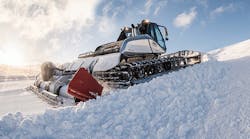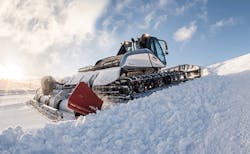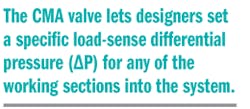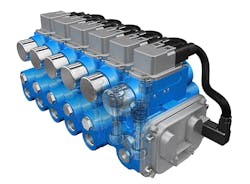Snow groomers designed and manufactured by Prinoth, based in Sterzing, Italy, push the limits of what is mechanically possible. These advanced vehicles must function within surprisingly rigid parameters, working flawlessly at temperatures down to –30°C, on icy and wet surfaces, and scaling inclines that can exceed 45 deg.
Snow groomers typically operate in the dark, after skiing hours. Operators must continually adapt blade positions to collect the right amount of snow given the snow humidity, temperature, and other variables. Operators depend on feedback to know their blade settings, which is a delicate art and science. They require fast reaction times and the ability to sense the blade position when starting or stopping a movement.
By 2010, Prinoth had made great advances in engine management, joystick operation, and touchscreen operation. But hydraulics in these punishing conditions still lagged. Eaton Hydraulics responded with components that helped Prinoth make smarter machines. In particular, Eaton’s CMA valves provide dynamic machine control (DMC) for high traction, precise control of implements, and automated functionality.
Upgraded Hydraulics
Older hydraulic technology applied to such wide and heavy accessories would generate noise and waste energy by using flow restrictions to control movement. Orifices that restrict flow also generate heat. If a traditional hydraulic approach was taken, the result could have easily been sluggish, hard-to-predict response times. For instance, viscosity changes in the oil as temperature changed would affect response times and reduce productivity by forcing operators to reduce speeds to maintain precise control.
Because the CMA valve functions as an embedded system, it communicates on the CANbus and does not require dedicated wiring. An embedded system simplifies both the manufacturing and the subsequent servicing.
With the Leitwolf model in particular, Prinoth used CMA valve technology to improve serviceability. The CMA valve allows Prinoth to use fewer hydraulic components, which means lower service costs and less service spending.
Prinoth can support its customer almost in real time by connecting remotely to perform initial analyses and sometimes even fix a problem immediately. Service technicians use a diagnosis program to effectively monitor valve status. Failures are reported to the driver to further identify and resolve potential problems. With embedded systems in more and more vehicles, logic became available for more service operations.
Controls Features and Benefits
Dynamic machine control is the driving force behind smarter machines, including snow groomers. Electronic load sensing with the CMA valve enables flexible control-system architecture and easily supports varying machine working settings along with a variety of pumps.
Flexible system architecture reduces routing complexity, saves on lengths of hose, and improves weight distribution of components on the vehicle chassis. These come as a result of the CMA valve sets, which allow up to eight multi-sectional and multibank combinations.
Hydraulic system designers can use the CMA valve with most conventional LS pumps, not just those from Eaton. The valve continuously monitors the flow balance, pressure, and temperature of the oil at its inlet port. It also monitors pressure signals from any work port in the system at roughly 700 Hz. Combined with spool response of –100% to +100% within 20 msec, this is fast enough to compensate for pressure spikes by modulating accelerations and decelerations to control the dynamic pressure of the actuators.
The CMA valve can also eliminate up to 70% of oscillation amplitude from harmonic resonance—boom bounce, for example. The residual 30% is typically difficult to detect externally.
An integrator can follow the load-sense pressure or keep the pump at constant pressure and eventually define a torque-limiting curve to prevent bogging down the power takeoff. The control acts through a pressure modulator in the load-sense line back to the pump.
The CMA valve lets designers set a specific load-sense differential pressure (âP) for any of the working sections into the system. The valve can reduce energy consumption by lowering the âP when a function does not need aggressive dynamic response. Conversely, it can provide quicker response when a specific load needs higher acceleration or deceleration when there’s an increase in vehicle speed.
Independent metering on the CMA valve unlocks the mechanical link between the amount of oil sent an actuator and the amount of oil routed back to tank. This capability opens up a wide range of control criteria to achieve simultaneous control of pressure and flow. Such dynamic response and inertial management allows for customized tuning of the load-control response using Eaton’s ProFX configuration software.
An intelligent flow controller embedded in the CMA valve has a tunable algorithm that can alter inertial directional control on the valve’s meter-in line and a dynamic tunable pressure control on its meter-out line. This combination of separately tunable and synchronized controls on the two independent spools enables fine dynamic response tuning and customizable load-feel feedback.
Daniel Galler is a Mechanical Engineer at Eaton’s Hydraulic Group in Northern Italy. For more information, call Eaton Hydraulics at (800) 386-1911, or visit www.eaton.com/hydraulics.





